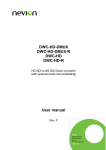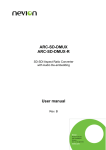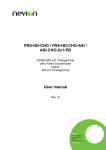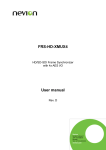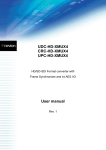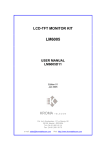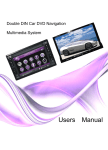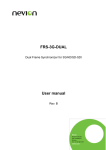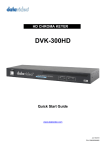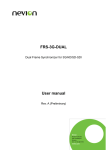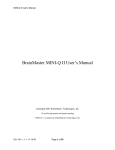Download DWC-HD User manual - AV-iQ
Transcript
DWC-HD HD-SDI to SD-SDI Down-converter (with optional Audio De-embedding) User manual Rev. 5 DWC-HD Rev. 5 Nevion Support Nevion Europe Nevion USA P.O. Box 1020 3204 Sandefjord, Norway Support phone 1: +47 33 48 99 97 Support phone 2: +47 90 60 99 99 1600 Emerson Avenue Oxnard, CA 93033, USA Toll free North America: (866) 515-0811 Outside North America: +1 (805) 247-8560 E-mail: [email protected] See http://www.nevion.com/support/ for service hours for customer support globally. Revision history Current revision of this document is the uppermost in the table below. Rev. Repl. Date Sign 5 4 3 4 3 2 2011-01-03 2008-12-15 2008-11-24 AA NBS NBS 2 1 0 1 0 - 2008-07-09 2008-06-18 2008-06-12 NBS NBS TB Change description New template. Added more information about minimum delay. Corrected number of SDI outputs in Chapter 1; Corrected table in Chapter 5; Added specification of minimum delay in Chapter 2. Added Block diagram in Chapter 1. Removed monitoring versions. First version for public release. nevion.com | 2 DWC-HD Rev. 5 Contents 1 Product overview ..................................................................................................... 4 1.1 Product versions .............................................................................................................. 4 2 Specifications .......................................................................................................... 6 3 Description............................................................................................................... 9 3.1 Data path ......................................................................................................................... 9 3.2 Video blocks overview ................................................................................................... 10 3.3 Optical/ Electrical input selection ................................................................................... 10 3.4 De-glitcher ..................................................................................................................... 10 3.5 Scaling block ................................................................................................................. 11 3.6 Frame synchronizer ....................................................................................................... 11 3.7 Video generator ............................................................................................................. 13 3.8 Video processing block .................................................................................................. 14 3.9 EDH processing block ................................................................................................... 14 3.10 Video output selection ................................................................................................. 14 3.11 Video DAC................................................................................................................... 14 3.12 Audio overview ............................................................................................................ 15 3.13 Audio de-embedder ..................................................................................................... 16 3.14 Audio delay.................................................................................................................. 16 3.15 Audio cross point matrix .............................................................................................. 16 3.16 Audio fallback options .................................................................................................. 16 3.17 Audio generator ........................................................................................................... 16 3.18 Audio processing block ................................................................................................ 16 3.19 Audio embedder .......................................................................................................... 17 3.20 Analog audio output ..................................................................................................... 17 4 Configuration ......................................................................................................... 18 4.1 DIP switch functions ...................................................................................................... 18 4.2 FACTORY reset function ............................................................................................... 19 4.3 GYDA mode .................................................................................................................. 20 5 Connections........................................................................................................... 22 6 Operation ............................................................................................................... 23 6.1 Front panel LED indicators ............................................................................................ 23 6.2 RS422 commands ......................................................................................................... 23 General environmental requirements for Nevion equipment..................................... 31 Product Warranty...................................................................................................... 32 Appendix A Materials declaration and recycling information..................................... 33 EC Declaration of Conformity ................................................................................... 34 nevion.com | 3 DWC-HD Rev. 5 1 Product overview The Flashlink DWC-HD-DMUX converts an HD-SDI input signal to an SD-SDI output signal with user selectable aspect ratio. Two digital outputs and a set of configurable analog video outputs are provided, all of which can be set to output the SD signal or the re-clocked original HD signal. For SD input the card will act as an SD frame synchronizer with an adjustable delay relative to the sync signal. This frame synchronizer functionality is also present when downconverting. The card is prepared to accept black & burst or a tri-level signal from the frame. The DWC-HD-DMUX also has a de-glitcher to give error-free synchronous switching. The audio embedded in the HD-SDI or SD-SDI stream is de-embedded and can be delayed relative to video. Each audio channel can be swapped in an audio matrix before they are reembedded in the SD-SDI data output stream. For SD-SDI inputs it is possible to turn embedding completely off and leave the SDI stream unaltered. A selection of user parameters of the card can be controlled by switches on the board. Complete control of all parameters is available by use of the Flashlink RS422 Control Protocol Version 4, which is supported by the Gyda system controller from software release 2.13. Figure 1: DWC-HD-DMUX-R block diagram 1.1 Product versions DWC-HD HD down-converter. With 2XSDI out, SD/HD analog out, internal audio handling, and frame synchronizer functionality. DWC-HD-R HD down-converter. With high sensitivity 9/125µm single mode optical input, 2XSDI out, SD/HD analog out, internal audio handling, and frame synchronizer functionality. DWC-HD-DMUX HD down-converter. With 2XSDI out, SD/HD analog out, internal audio handling, analog stereo out, AES (or RS-422 data) out, and frame synchronizer functionality. nevion.com | 4 DWC-HD DWC-HD-DMUX-R Rev. 5 HD down-converter. With high sensitivity 9/125µm single mode optical input, 2XSDI out, SD/HD analog out, internal audio handling, analog stereo out, AES (or RS-422 data) out, and frame synchronizer functionality. nevion.com | 5 DWC-HD Rev. 5 2 Specifications Optical SDI input Data rate optical: Sensitivity - HD-SDI (1485 Mbps): - SD-SDI (270 Mbps): Detector overload threshold: Detector damage threshold: Optical wavelength: 270 – 1485 Mbps Transmission circuit fiber: Connector return loss: Connector: 9/125um Single Mode >40dB w/ SM fiber SC/UPC Better than -22dBm Better than -22dBm Min. -3dBm >+1dBm 1200-1620nm Electrical SDI input Connectors Equalization Input Return loss Jitter tolerance 75 Ohm BNC Automatic: - >300m @270Mbps w/Belden 8281, BER < 10E-12 - >100m @1485Mbps w/Belden 1694A, BER < 10E-12 >15dB, 5MHz -1.5GHz - SD limit: - 10Hz-1kHz: >1 UI - 10kHz – 5MHz: >0.2 UI - HD limit: - 10Hz-100kHz: >1 UI - 100kHz–10MHz: >0.2 UI Electrical Sync input Connector Format Input Return loss 75 Ohm BNC Black & Burst, Tri-level <-35dB @ < 10MHz, 30dB @ < 30MHz Electrical SDI outputs Number of outputs Connectors Output Return loss Output signal level Output signal rise / fall time, 20% - 80% Amplitude overshoot Output timing jitter Output alignment jitter 2 75 Ohm BNC >15dB, 5MHz -1.5GHz 800mV +/- 10% - SD limit: [0.4ns – 1.5ns]; <0.5ns rise/fall var. - HD limit: < 270ps, <100ps rise/fall var. <10% - SD: <0.2 UI - HD: <1 UI - SD: <0.15 UI - HD: <0.15 UI Analog Video output, NTSC/PAL Number of outputs Connector DC offset 1 Component RGB/ YUV or 3 CVBS 3 x 75R BNC < 0±15mV nevion.com | 6 DWC-HD White level, NTSC Sync level, NTSC Return loss White level, PAL Sync level, PAL Diff gain Diff phase AM noise PM noise S/N 2T K-factor (2T pulse distortion) Luma non-linearity Output resolution Rev. 5 100±1 IRE 40±1 IRE > 35dB @ 10MHz, >40dB @ 5MHz 100±1 IRE 40±1 IRE <0.5% <1deg < -60dB < -60dB < -60dB < 0.5% < 2% 10 bits Analog Video output, HD Number of outputs Connector DC offset White level Return loss Output resolution 1 component RGB/ YPbPr 3 x 75R BNC < 0±15mV 100±1 IRE > 30dB @ 30MHz 10 bits Analog Audio output Number of outputs Connectors Impedance Dynamic range Crosstalk THD+N Frequency response Output level Common mode DC immunity Level adjustment range Two tone intermodulation Output resolution 1 stereo pair 2 x WECO audio connectors < 66R >100dB(A) < -60dB 20Hz-20kHz -70dB 20Hz-20kHz +/- 0.5dB 24dBu +/- 1dB 0 – 48V 0 – 24dBu with 1db step < -80dB 24 bits AES output Number of outputs Connectors Return loss Output jitter 1 WECO audio connector 110R +/-20% 0.1MHz – 6.144MHz <0.0025UI peak Supported standards SD, 270 Mbps HD, 1485 Mbps Analog video Centre of picture definition SMPTE 259M, SMPTE 272M-AC SMPTE 292M, SMPTE 274M, SMPTE 291M, SMPTE 296M, SMPTE 299M SMPTE 170M, SMPTE 274M, ITU-R. BT.470, ITU-R. BT.709 Part 2 SMPTE RP187, ITU-R. BT.470 nevion.com | 7 DWC-HD Aspect ratio preservation Color space conversion Video switch point definition and sync AES Optical EDH Video Payload Identification Rev. 5 SMPTE RP199-1999, SMPTE RP221 HD: ITU-R. BT.709 SD: ITU-R. BT.601 See also ITU-R. BT.1361 for more information SMPTE RP168 (tri-level), SMPTE 170M, ITU-R. BT.470 AES3-1996 SMPTE 297M, SMPTE 292M Compliant to SMPTE RP165 SMPTE 352M-2002 Minimum video signal delay through processing Minimum delay [Field+Lines] Input standards Full frame Cropped edge Letterbox (NTSC) Regular input standards: 1920/1080i50 0+10 0+41 1920/1080i59.94 0+10 0+41 1280/720p50 0+10 0+41 1280/720p59.94 0+10 0+41 Progressive input with low frame rate: 1920/1080p25 1+10 1+41 1920/108p29.97 1+10 1+41 1280/720p25 1+10 1+41 1280/720p29.97 1+10 1+41 Input standards for telecine converters: Minimum delay [Frame+Lines] 1920/1080p23.97 1+10 1+41 1280/720p23.97 1+10 1+41 Letterbox (PAL) 0+44 0+44 0+44 0+44 1+44 1+44 1+44 1+44 1+44 1+44 Other Power consumption 5V – 5.3W (4.9W without optical receiver) 15V – 2.55W -15V – 0.7W nevion.com | 8 DWC-HD Rev. 5 3 Description 3.1 Data path The HD/SD-SDI input selected from the optical or electrical input is equalized, re-clocked and de-serialized and transferred to a processing unit (FPGA). In the FPGA the signal is sent through a de-glitcher that cleans up erroneous video lines, for instance due to switching. After the de-glitcher the video is sent to the Audio de-embedders, where audio is split from the video. 3.1.1 Audio data path The 16 audio channels coming out of the de-embedder are bundled in pairs and sent to an audio store buffer. After a user specified delay the audio is fetched from the audio store buffer and sent to an Audio Cross Point. The 10 audio outputs from the Audio Cross Point can be any pair of audio channels de-embedded from the incoming video stream, a generated 1 kHz sine, or a generated black sound (a legal audio stream with silence only). As part of the audio cross point, missing output pairs can be replaced with generated fallback signals. From the cross point outputs each stereo pair enters an Audio Processing Block where channels can be processed or rearranged within each channel pair. Finally, eight stereo pairs are routed to the Audio Embedder and the two remaining pairs are sent to the audio DAC and the AES out, respectively. 3.1.2 When down-converting HD video The video is routed to a Scaling block and the resulting SD video is passed to a Frame synchronizer block. If video is missing, an internal video generator can be switched in as a fallback source. The video then passes through a Video processing block with an integrated Legalizer, before entering an EDH processing block where the user can select to insert updated EDH flags. Although audio is re-embedded before the video processing block, the video processing and EDH processing blocks will not manipulate the audio data. After passing the EDH block, the video stream with embedded audio is sent in parallel out of the FPGA and into a serializer that re-clocks the data and sends the SDI to a buffered output switch. The buffered output switch can be viewed as 3 simple switches, each selecting between the equalized and re-clocked output (Through mode) and the down-converted output (Processed mode). The output of the first two switches are sent to two paired (inverting and noninverting) digital outputs, whereas output of the third switch is sent to the onboard video DAC. 3.1.3 When frame synchronizing SD video The video data path when operating as an SD frame synchronizer is conceptually the same as when down-converting, except that the Scaling block is not needed, placing the Frame synchronizer block directly after the de-glitcher. nevion.com | 9 DWC-HD Rev. 5 3.2 Video blocks overview Figure 2: Video function blocks when down-converting HD to SD 3.3 Optical/ Electrical input selection The DWC-HD-DMUX has both an optical and an electrical input. The active input can be chosen either by an automatic selection based on a prioritized list of inputs and a selected rule of switching or by manual selection. When in Gyda over-ride mode (control by DIP switches), the card will use the priorities and rule saved from the last Gyda session. Automatic selection mode Mode under Video in in Gyda must be set to auto. Three input choices can be made for three priorities; optical, electrical or mute. The priority is the order in which the board will look for a valid input. It is also possible to set a rule for when the input should be switched to the next priority. The rules are: - lol (loss of lock) - los (loss of signal) - EDH (Errors are found in the video frame) Hold time determines how long a signal has to be missing/unlockable/contain errors to be considered lost, while Lock time determines how long a higher prioritized signal has to be present/locked/error free before it again can be considered to be present and stable. This is described in more detail in chapter 3.6.1, most mainly in the two “If video input disappears” sections. 3.4 De-glitcher The de-glitcher corrects timing errors within a line of video. The de-glitcher has a buffer of 13.6 µs for HD and 50 µs for SD. When the first signal is present, we call it the “initial phase signal”, data is taken from the centre of this buffer. If the timing reference of the video signal changes, for instance when a new source is being switched into the signal path, the timing errors occurring by this change will be corrected if the new timing reference is within ±6.8 µs (for HD, ±25 µs for SD) of the “initial phase signal”. This also goes for all consecutive timing references. nevion.com | 10 DWC-HD Rev. 5 If a signal occurs that is more than ±6.8 µs (for HD, ±25 µs for SD) off relative to the “initial phase signal”, the output will repeat the last frame, refill the buffer and take out data from the centre of the buffer. This new signal is now considered the “initial phase signal”. Hence, it produces an error free video output without frame wrapping when the video input comes from a router with synchronous input video signals that all lies within ±6.8 µs (for HD, ±25 µs for SD) of each other. 3.5 Scaling block The Scaling block is the heart of the down-converter. The frame rate of the HD input dictates the video standard that the Scaling block will produce: If the input is 50Hz-based, e.g. 1080/25p, the output will be 576/50i, and if the input is 60Hz-based (with or without pulldown), e.g. 720/59.94p or 1080/24p, the output will be 486/29.97i. The following assumes that the aspect ratio of the incoming HD is 16:9, and that the pictures are such that objects are shown geometrically correct on a 16:9 monitor. The user must then set the crop and aspect ratio of the output and the illustration below shows the options available. The figure assumes a 4:3 monitor that ignores the WideScreen Signaling bits (WSS bits can be inserted automatically according to the selected aspect ratio, or they can be turned off or replaced by a user selected value. See chapter 3.11 for details.) Had the monitor in the example processed WSS bits, the full-frame picture in the lower left would’ve been internally converted and shown letterboxed to preserve picture geometry. The cropped edge 4:3 and letterboxed 16:9 options should normally only be used for 4:3 monitor. Figure 3: Picture cropping and geometry options 3.6 Frame synchronizer The frame synchronizer consists of a frame store buffer and some control logic. The frame store buffer can store up to 8 SD frames. When the input is an HD source to be converted to SD, the frame synchronizer is placed after the Scaling block. When the input is SD, the frame nevion.com | 11 DWC-HD Rev. 5 synchronizer is placed directly after the De-glitcher block. The control logic sets the frame synchronizer in different modes of operation based on the presence of a sync input. 3.6.1 Frame Sync mode If a sync input (B&B or Tri-level) is present, the frame synchronizer will output a signal that has a delay relative to this signal. Two parameters can be set; output phase delay and minimum delay. The output phase delay can be positive or negative and sets the difference between the phase of the sync input and the video output. The minimum delay sets the minimum delay between video output and video input. The actual delay can be larger than the minimum delay (hence the name), because the card must also adjust the phase relative to the sync input. The user may set the minimum delay up to 7 frames. Example: The HD-SDI input signal is 12 lines delayed to a tri-level input signal. The minimum delay is set to 1 frame, 0 lines and 0 samples. The output phase delay is set to 5 samples. The actual delay between the input video and the output video will be 2 frames and 5 samples. If video input disappears Given that stable SDI input and sync input both exists: If the SDI input disappears, and Video in and Processed video out are set to Auto, the board will hold on to the current input whilst frame freezing for a time set by Hold time in Video in. The board will then select the next input in the prioritized list. If that input is the internal video generator, the pattern selected in Video generator will be output. Defaults are optical input as first priority, then electrical, and finally fallback to Black video, with a Hold time of 3 seconds. Note that input selection can be based on several rules, of which only Loss of signal (los) is based on a status that can be checked for both inputs at the same time. This means that for Los a direct jump from priority 1 to priority 3 is possible (in one Hold time period, because priority 2 can be checked at the same time as priority 1), while the other rules require one Hold time period for each jump between priority levels. It the board only has one physical input in use, it is therefore recommended to set Video generator as the second priority. If the SDI signal disappears and mode is set to manual in one or both of Video in and processed video out, the effect will be that the board can frame freeze but will never switch to another video input, including the fallback generator. If video input reappears Given stable sync input, the video will reappear after a user specified time of locked video. This Lock time (in Video in) defaults to 3 seconds. If sync input disappears Given that stable SDI input and sync input exists: If the sync signal disappears, the board will act as in frame delay mode, see Chapter 3.6.2. NOTE: This will result in a frame roll as the delay changes. If sync input reappears Given that a stable SDI input exists: If the sync signal reappears the delay mode will change back to Frame Sync mode. Hence the internal clock will be locked to the sync signal and the delay will change again. NOTE: This will result in a frame roll as the delay changes. If both signals disappears nevion.com | 12 DWC-HD Rev. 5 The picture will first freeze for a user specified time (Hold time in Video in), and then possibly (See section “If video input disappears” above) go to a fallback generator. The output is now referenced to the local clock source. However, this clock source will be kept within 1 ppm of the last sync source. 3.6.2 Frame delay mode In this mode a sync signal is not present. The delay set is then directly related to the incoming video. 1 frame and 1 line delay means that the output will be 1 frame and 1 line delayed version of the input. If video signal disappears The picture will first freeze for a user specified time (Hold time in Video in), and then possibly (See section “If video input disappear” under Frame sync mode above) go to a fallback generator. The output is now referenced to the local clock source. However, this clock source will be kept within 1 ppm of the last video source. If video signal reappears The video output will reappear after a user specified time of locked video. This Lock time (in Video in) defaults to 3 seconds. The delay will now be the same as before loosing input. NOTE: This may cause a frame roll. If a sync input appears Given that a stable SDI input exists: If a sync signal appears the delay mode will change to Frame Sync mode, see Chapter 3.6.1. Hence the internal clock will be locked to the sync signal and the delay will once again change. NOTE: This will result in a frame roll as the delay changes. 3.7 Video generator The video generator can produce different simple signals: Color bar, Check field and flat field. The flat field option allows the user to specify any combination of luma and chroma values, or to select a predefined color from the following list: - Black - White - Yellow - Cyan - Green - Magenta - Red - Blue In normal operation (as a fallback generator), the video generator will take its video standard setting from the last lockable video input seen by the board. To enable the board to act as a standalone and user configurable video generator, the video generator must be either set as the first priority input when Mode is auto, or selected manually by setting Mode to Video generator. Both settings are done in Processed video out. This will override any video input but the generator signal will still be locked to the sync or SDI inputs, if present. For true standalone generator operation, the inputs should be removed. Available video standards are 486/25i and 576/25i. nevion.com | 13 DWC-HD Rev. 5 3.8 Video processing block The video processing block consists of a gain and offset adjustment, and a video payload legalizer. 3.8.1 Gain and offset The gain and offset adjustment is done separately on the Y, Cb and Cr samples. Luma gain Chroma gain Luma offset (gain =1) Chroma offset (gain = 1) Range Gyda 0 – 32767 (0-4x, 1x = 8192) 0 – 32767 (0-4x, 1x = 8192) -4095 – 4095 (-511.75 – 511.75 in sample values) -2047 – 2047 (-255.75 – 255.75 in sample values) 3.8.2 Video payload legalizer The legalizer hard clips the upper and lower limit of the video payload. With the legalizer enabled the limits are: Upper limit Luma: Chroma: Lower limit Luma: Chroma: With the legalizer disabled, 3FBh and 004h. 3ACh 3C0h 040h 040h the video processing block hard clips both luma and chroma to 3.9 EDH processing block If enabled, the EDH processing block extracts the EDH package from the video, updates the EDH flags according to SMPTE RP165 and inserts the EDH package into the ancillary data of the video. If disabled, The EDH processing block only reads, process and report the EDH package without changing it in video stream. 3.10 Video output selection The board has four digital outputs and group of three analog outputs. The four digital outputs are organized as two pairs, each consisting of an inverting and a non-inverting output. Each pair and the analog group can take their signal directly from the re-clocker or from the output of the processing unit. In Gyda the direct paths are labeled Through and the processing paths are labeled Processed. 3.11 Video DAC The video DAC has three configurable outputs, with the following combinations available: - CVBS/CVBS/CVBS - CVBS/Y/C - Y/Pb/Pr - R/G/B This setting only applies to SD video. When HD video is routed to the video DAC, the output will always be YPbPr. For CVBS and S-Video the following modulations are available: - PAL B/G - NTSC nevion.com | 14 DWC-HD Rev. 5 - PAL M - PAL N The board can handle 50Hz-based input signals as well as 60Hz-based with and without pulldown, but can’t convert a 50Hz-based input to a 60Hz-based output and vice versa. The modulation setting is therefore split in two, one to select between NTSC and PAL M output for 60Hz-based sources, and one to select between PAL B/G and PAL N for 50Hz-based sources. It is also possible to turn black setup (“pedestal”) on or off. This setting only applies to NTSC. PAL Wide Screen Signaling (WSS) is also supported, and while the HD input is always 16:9, SD inputs can have value already embedded. The user can select to strip off any existing WSS information by setting mode to Off, or to override the current WSS value by setting mode to On and specifying a new value, or set the mode to Auto. When input is HD, the Auto mode will insert WSS data according to the selected aspect ratio in the scaler block. When the input is SD, the Auto mode will signal 4:3 or 16:9 based on the aspect ratio bit in SMPTE 352M byte 3, or turn WSS off if no SMPTE 352M packages are available. When specifying WSS values, the user should observe that the WSS value is really a 14-bit number with other information besides just aspect ratio. Aspect ratio is contained in the lower 4 bits, and the table below covers only those bits. WSS value Aspect ratio Picture placement Active lines 0+8=8 4:3 Full 576 1+0=1 14:9 Letterbox centre 504 2+0=2 14:9 Letterbox top 504 3+8=11 16:9 Letterbox centre 430 4+0=4 16:9 Letterbox top 430 5+8=13 >16:9 Letterbox deeper than 16:9 undefined 6+8=14 14:9 Full-height 4:3, framed to be “14:9-safe” 576 7+0=7 16:9 Full-height 16:9 (anamorphic) 576 Note the occasional “+8” in the first column above. It stems from the fourth aspect ratio bit, a parity bit over the first three. 3.12 Audio overview Figure 4: Audio function block nevion.com | 15 DWC-HD Rev. 5 3.13 Audio de-embedder The Audio de-embedder extracts all audio embedded in the video stream. The de-embedder is always enabled when the input is HD. When the input is SD and the board operates as an SD frame synchronizer, embedding can be globally disabled. The effect is to leave the SDI stream unaltered, except for repeated or removed video frames. 3.14 Audio delay An audio delay can be specified relative to the video output. It is situated before the audio cross point matrix and is common for all de-embedded channels. The audio delay is specified in terms of 48 kHz audio samples, and can be set to positive or negative values. NOTE: As the audio delay is relative to the video output it is possible to specify an audio delay that will actually be a negative delay, i.e. ask that the sound is sent from the card before it is received. This will obviously cause audio errors. 3.15 Audio cross point matrix The audio cross point matrix is a 10x10 cross point with inputs and outputs as shown in Figure 4. The 8 de-embedded channels, a 1 kHz sine and “black sound” are selectable inputs. “Black sound” is explained in chapter 3.1. The outputs of the cross points are 8 stereo channels for re-embedding, one analog audio output and one AES output. 3.16 Audio fallback options The 10 output channels from the cross point matrix have configurable fallbacks, used when their corresponding matrix inputs are missing. A common fallback setting is used for all eight re-embedder channels, whereas the audio DAC channel and AES out have their own independent fallback settings. The priorities can be selected between matrix (being the selected channel in the cross point matrix) or the internally generated sine or black sound. 3.17 Audio generator The stereo audio generator is available as an input to the audio cross point matrix, and as a fallback option. There are therefore three slightly different ways to select the generator: select it in the matrix directly, select it as the first priority under audio fallback, or to set it as second priority behind a missing input. The generator signal is a high purity 1 kHz sine wave with a 250ms interruption on the left channel every 3 seconds. The audio level may be set to one of two standards. The two levels are -18 dBFS and -20 dBFS. These two levels correspond to EBU R68 and SMPTE RP155. 3.18 Audio processing block The output of each stereo signal from the audio cross point matrix may be manipulated in the audio processing block (LL, RR, LR, RL !LR, L!R, (L+R)/2, MS). The stereo signals may be output in one of the following ways: - LR, Left / Right - RL, Right/ Left - LL, Left/ Left - RR, Right/ Right - !LR, ØLeft/ Right - L!R, Left/ ØRight - MM, (Left + Right)/2 - MS, MS/AB No change. Channels are swapped. Left channel is copied into the right channel. Right channel is copied into the left channel. The left channel is phase inverted. The right channel is phase inverted. The left and right channels are summed. The left and right channels are converted from AB stereo to MS stereo. nevion.com | 16 DWC-HD Rev. 5 3.19 Audio embedder The audio embedder can be enabled/disabled per group. When a group to be embedded is disabled the audio inside that group is removed. A 24-bit audio signal uses the Extended Audio Data Packet for the 4 least significant bits. Not all equipment can handle Extended Audio Data Packets correctly, so the option exists to truncate all audio data to 20 bits. This setting is common for all embedder channels. The insertion of Audio Control Packages can also be switched on and off. This setting is also common for all embedder channels. For SD input (i.e. operation as a frame synchronizer) the audio embedder can also be switched off all together. In this state all audio embedded on the input signal is left unchanged. 3.20 Analog audio output The level of the analog audio output can be adjusted in GYDA. The minimum step is 0.5dB (input will be rounded to nearest 0.5dB) and the range is from -95.5dBu to 24dBu. It is also possible to mute the output completely. nevion.com | 17 DWC-HD Rev. 5 4 Configuration 4.1 DIP switch functions The two sets of DIP switches are labeled with a number running from 1 to 15. The 16th DIP is labeled OVR. Note that the left DIP switch of the horizontal DIP package is number 1. The top DIP switch of the vertical DIP package is number 9. Default settings as delivered from factory should be all DIPs in the Off position. The module will then be under Gyda control, see description for DIP switch 16 below. Table 1: Switch # 1 DIP SWITCH FUNCTIONS Function name SDI OUT 1 + Video DAC out Function DIPs Off: processed mode On: through mode 2 SDI OUT 2 Off: processed mode On: through mode 3-4 Aspect ratio DIP[3 4] = [Off Off] => 16:9 DIP[3 4] = [Off On] => 4:3 DIP[3 4] = [On Off] => 16:9 LB DIP[3 4] = [On On] => Previous setting preserved 5-6 SD video DAC format DIP[5 6] = [Off Off] => CVBS DIP[5 6] = [Off On] => YPbPr DIP[5 6] = [On Off] => SVideo DIP[5 6] = [On On] => RGB 7 SD video DAC modulation Off: PAL B/G + NTSC On: PAL N + PAL M 8 Black setup disable Input priority Off: Black setup for NTSC On: No black setup Off: Optical input has priority On: Electrical input has priority Audio DAC and AES group DIP[10 11] = [Off Off] => Gr1 DIP[10 11] = [Off On] => Gr2 DIP[10 11] = [On Off] => Gr3 DIP[10 11] = [On On] => Gr4 9 10 - 11 Comment In through mode the video goes through a re-clocker only, and the video DAC output will also be HD (always YPbPr). In through mode the video goes through a re-clocker only. These 2 DIPs choose aspect ratio for down-converted video. “Previous setting preserved”: With DIPs in this position before the module is booted into manual mode; the module will keep the previous value set by Gyda. These two DIPs choose video DAC output format for SD output. Analog HD is always YPbPr. Selection between PAL B/G and NTSC or PAL M and PAL N is automatic, based on video input. For NTSC only. This switch has no effect for boards without the optical input (-R option). The 2 first of these 4 DIPS select one of the de-embedded groups. The next two nevion.com | 18 DWC-HD Switch # 12 Rev. 5 Function name Audio DAC channel Function DIPs Off: Ch1 On: Ch2 (from selected group) Off: Ch1 On: Ch2 (from selected group) Comment DIPs select a channel pair (within this group) for the audio DAC and one for the AES output, respectively. The two slide switches on the bottom side of the board must also be switched. See ch. 4.2.2below. This DIP is only read during boot. The board will not start when DIP 16 and this DIP are both set to On. After returning the DIP to normal position, the card must be restarted and kept powered for a minimum of 10s to complete the reset. The reset will only affect settings not pertaining to DIPs and the rotary switch. This DIP is only read at power up. OVR is short term for GYDA override. 13 AES channel 14 AES/Dlink Off: AES3 out on AES output On: Data link out on AES output 15 RESET Off: Use values preset by GYDA On: RESET to factory defaults 16 OVR Off: GYDA mode On: Manual mode 4.2 FACTORY reset function A factory reset is a 3 step process: - Set DIP 15 to ‘on’ and boot the card. - Remove power and set the reset switch back to normal position (‘off’) - Power up card once again. The operation of the card will immediately reflect the freshly loaded default settings. However, the card must be kept powered for at least 10 seconds to ensure that these settings are stored locally to be retrieved again at the next start-up. The cards operational environment must also be kept static during those 10 seconds (i.e. no change in incoming video standard, no commands issued). Failing to meet this requirement could result in an incomplete reset and require the user to restart the factory reset sequence. 4.2.1 Rotary switch and push buttons The rotary switch, labeled DLY, adjusts the phase delay from -5 to +4 video lines. It is only functional when a sync signal, black & burst or tri-level, is present at the sync input. The rotary switch is accessible from the board front. nevion.com | 19 DWC-HD Rev. 5 The push buttons, labeled INC and DEC, are used to fine adjust the phase delay by samples. It can adjust ±½ video line for the current video standard (or the last video standard the board was able to lock to). Pressing a button and keeping it pressed will accelerate the change. The LED adjacent to the button will flash for a short period of time when the end of the adjustment range has been reached. Pressing both buttons at the same time will return to the middle of the adjustment range, and the board will acknowledge by flashing the INPUT and SYNC LEDs simultaneously. 4.2.2 Slide switches The two switches at the top of the module (rear side) switch between AES out and Data out. It DC couples the output signal when in DATA out mode, and AC couples the signal when in AES mode. Note that to enable Data link output on the AES connector it is also necessary to set DIP 8 to the Off position when the board is in Manual mode (DIP 16 = On), or when the board is in Gyda mode (DIP 16 = Off), to select Data link over AES output in Gyda. Slide switches moved to the right routes out AES. The switch on the left card edge switches between backplane sync input and Flashlink distributed sync (Future feature upgrade of Flashlink frame). Switch moved up routes the backplane sync to the card. Figure 5: The figure shows a bottom view component printout of the board. Note the location of the slide-switches. 4.3 GYDA mode All functions of the card can be controlled through the GYDA control system. The GYDA interface has an information page and a configuration page. 4.3.1 Information page The information page shows a dynamic block-diagram of the board and some additional information text. The block diagram updates with the board status, showing selected input signal, missing signals (by red crosses over the appropriate signal lines) and signal routing (by graphic switches). It also shows the audio matrix selections that have been made in the configuration page. Note that if a stereo pair of embedded audio is missing, the user will still be allowed to select that pair from the audio matrix. The output will however go to the fallback position immediately. A missing stereo pair will be shown in the block-diagram as a red cross over the appropriate matrix input line. nevion.com | 20 DWC-HD Rev. 5 The text on the information page gives information about functionality not displayed on the dynamic block diagram. The video delay represents the actual delay between input and output video. The audio de-embedders 1-4 show the state of the audio control package for their associated audio group de-embedded from the input stream. The audio embedders 1-4 show the state of the audio control package and the audio bit depth for their associated audio group embedded in the output stream. Embedded UART shows the data rate of the data link embedded in the audio control packages on the incoming signal. 4.3.2 Configuration page The different configuration possibilities are explained in Chapter 3, under the corresponding blocks or functions. nevion.com | 21 DWC-HD Rev. 5 5 Connections Figure 6: DWC-HD-DMUX-C1 The backplane for the DWC-HD-DMUX is labeled DWC-HD-DMUX-C1. The table below shows the connectors and their functions. Function HD/SD-SDI input HD/SD-SDI output 1 HD/SD-SDI output 2 Analog video, Y/G/CVBS Analog video, Pb/B/Y Analog video, Pr/R/C Sync input Analog audio out left channel Label IN O1 O2 Y/G/CVBS PB/B/Y PR/R/C SYNC AAL Connector type BNC BNC BNC BNC BNC BNC BNC WECO Audio connector Positive GND Negative Analog audio out left channel AAR WECO Audio connector Positive GND Negative AES out AES WECO Audio connector Positive GND Negative Optical input OPT1 BSC-II (for SC input) nevion.com | 22 DWC-HD Rev. 5 6 Operation 6.1 Front panel LED indicators Diode \ state Card status Red LED PTC fuse has been triggered or FPGA loading has failed Orange LED FPGA loading. If more than a few seconds: DIPs 14+15 both set to the ‘On’ position, or module not programmed Video signal present but card not able to lock VCXO Green LED Module is OK No light Module has no power SDI input status Video signal absent Video input signal in lock Sync signal absent Sync signal present but card unable to lock VCXO B&B or Trilevel sync in lock No audio embedded in incoming video One, two or three audio groups embedded in incoming video 4 audio groups embedded in incoming video Module not programmed, or DIPs 14+15 both set to the ‘On’ position Module not programmed, or DIPs 14+15 both set to the ‘On’ position Module not programmed, or DIPs 14+15 both set to the ‘On’ position Sync input status Audio input status 6.2 RS422 commands 6.2.1 FLP4.0 required commands Block Blk # Commands Example Response Control - - ? ? product name\ SW rev n.m\ FW rev r.s\ protocol ver 4.0\ Hello command. Note 1: No other commands will be available until the card has received this hello. Note 2: This command will also enable checksums. Note 3: Cards are designed to be hot-swappable. To sync with the start of a new command, the cards will wait for a <lf> character before looking for a valid command. conf 0 - conf 0 *too long to list* Configuration settings Retrieves the card's configurable settings. Each addressable block is represented by a single line. Dynamic status may be included in response, but is usually reported in info only. - - info info *too long to list* Dynamic status info Blocks with static settings only will usually not be included, see conf nevion.com | 23 DWC-HD Block Rev. 5 Blk # Commands Example Control Response above. - - chk off chk off ok Checksum off If issued twice in succession, this command will disable checksums. Note: Responses will still have the checksums appended. NOTE1:? command turns the checksum on again - - locate on <seconds> locate on 3 ok locate off locate off Card locator This command will cause all the LEDs to flash for a user specified number of seconds. If omitted, the value <seconds> will be set to a default of 120 seconds. The flashing can be terminated at any time with locate off. - - address address address <address> Card address This command will force the module to check and update its current rack and slot address. This is normally only done at start-up. - - filename filename dwchddmux0-105.ffw <name>'.'<extensio Firmware update n> The <name> part must match the card's hardware and include a revision number, and the extension must be either 'ffw' for FPGA firmware or 'mfw' for microcontroller firmware. After running this command the board will be ready to receive its new firmware in Intel-hex format. - - fin fin ok Finalize Finalize the programming of the microcontroller. See description of the uC boot loader (separate document). misc 0 - NOT AVAILABLE BY COMMAND. ONLY FOUND in conf 0 prog | fin Misc info prog if the card is freshly programmed by the boot loader and the program is still un-finalized. fin is the normal condition. ovr if DIP-switch 16 is set to the ON position and the card is under DIPswitch control. Note 1: The info part of misc has additional functionality when locate is used: locating <remaining seconds>. This enables a visible countdown clock in Gyda, but is not a required part of FLP400. ' ' | ovr nevion.com | 24 DWC-HD Rev. 5 6.2.2 Normal control blocks Block Blk # Commands Example Response Control pin 0 on | off pin 0 on pin 0 off cd | ncd Pin diode for optical input. No control available, except to turn power to the pin diode on or off. The info string reports carry detect or not carry detect. ceq 0 - ceq 0 cd | ncd Cable equalizer for electrical input. No control; only used to report carry detect or not carry detect. cho 0 pri <k> | pri <k> <l> | pri <k> <l> <m> cho 0 pri 0 cho pri 0 1 cho pri 10 2 size 3 pri k,l,m auto latch <latch_status> t1 <hold time> t2 <lock time> <rule> Video input select pos man <k> | pos auto latch on | latch off| latch reset rule lol | rule los | rule trse t1 <hold_time> t2 <lock_time> cho 0 pos man 1 cho 0 pos auto cho 0 latch on cho 0 latch off cho 0 latch reset cho 0 rule lol cho 0 rule los cho 0 rule trse cho 0 t1 1000 cho 0 t2 1000 pri: a prioritized list of inputs, used when change-over is automatic. The list can have 1, 2 or 3 entries, or levels. Manual mode is effectively the size 3 pri k,l,m man same as automatic mode with one m latch priority level only, but has its own command. <latch_status> t1 0 = from optical input <hold time> t2 <lock time> <rule> 1 = from electrical input 2 = generator (from cho 1) latch: <latch_status> can be either on or off and selects if the changeover is latching or not, used when change-over is automatic. Latch on means that if we've lost our main source and moved on to a lower priority level, we'll not search to see if the higher pris will reappear. rule: <rule> can be either los, lol or trse, which means loss off signal, loss of lock, and timing reference signal error. This determines what triggers an automatic change-over. t1 and t2: change-over doesn't happen immediately, as a precaution against glitches and unstable signals. The timers t1 and t2 let the user decide how long (in ms) we will cling on to a missing input before we consider it gone and move on to the next pri level, and how long an input with a higher priority should be present before we consider it repaired and switch back, respectively. Note 1: the latch setting only applies to rule los. Note 2: the card change back to physical inputs from generators regardless of latch setting. As a side note, this means that t2 is important even when rule=lol and/or latch is on. Note 3: If we have selected rule=lol and a 3-level pri list with two physical inputs on top and a generator at the bottom and we're in generator mode (lost both physical inputs) and both nevion.com | 25 DWC-HD Block Blk # Rev. 5 Commands Example Response Control physical inputs reappear at more or less the same time, which physical input will be chosen is unpredictable. This again due to having one reclocker only and having to hunt for a valid input in the background while the generator is still selected. cho 1 pri <k> | pri <k> <l> cho 1 pri 0 cho 1 pri 0 1 pos man <k> | pos auto cho 1 pos man 1 Video fallback setting Second video change-over. This cho size 3 pri k,l man m is a slave of cho 0, in the sense that it has no latch, t1, t2 or rule settings of its own. It has a generator input that must be set up separately and that allows a switch to an internal video generator. 0 = from cho 0 1 = from video generator, vgen 0 2 = kill size 3 pri k,l auto Note: manual mode is the same as automatic mode with a priority list with only one priority level. cho 211 pri <k> | pri <k> <l> cho 2 pri 1 cho 5 pri 0 2 size 4 pri k,l Audio fallback setting Audio change-over blocks, one cho per audio output from the audio matrix, mtx 0. No other settings but the priority list. 0 = from audio matrix 1 = sine 2 = black 3 = kill Note: Only generators (pri 1, 2 or 3) are allowed to be set as first and only priority. cho 12 pri <k> | pri <k> <l> cho 12 pri 1 cho 12 pri 0 2 size 4 pri k,l Audio common fallback setting A short-cut to set change-over’s 2-11 all at once. Will of course not report anything in info, that's left to the individual cho blocks. cho 13 pos man <k> cho 13 pos man 0 cho 13 pos man 1 size 2 man k AES output select This change over has only manual mode and works as a simple 2:1 switch. 0: AES is selected 1: Embedded UART is selected cho 14 pos man <k> cho 14 pos man 0 cho 14 pos man 1 size 2 man k EDH insert select This change over has only manual mode and works as a simple 2:1 switch. 0: EDH off 1: EDH on cho 15 pos man <k> cho 15 pos man 0 cho 15 pos man 1 size 2 man k SDO 0 output select This change over has only manual mode and works as a simple 2:1 switch. 0: Through mode (re-clocked only) 1: Processed mode (from FPGA) cho 16 pos man <k> cho 16 pos man 0 cho 16 pos man 1 size 2 man k SDO 1 output select This change over has only manual mode and works as a simple 2:1 nevion.com | 26 DWC-HD Block Rev. 5 Blk # Commands Example Response Control switch. 0: Through mode (re-clocked only) 1: Processed mode (from FPGA) cho 17 pos man <k> cho 17 pos man 0 cho 17 pos man 1 size 2 man k Video DAC output select This change over has only manual mode and works as a simple 2:1 switch. 0: Through mode (re-clocked only) 1: Processed mode (from FPGA) cho 18 pos man <k> cho 18 pos man 0 cho 18 pos man 1 size 2 man k Audio embedding enable for SD This change over has only manual mode and works as a simple 2:1 switch. 0: embedding off (Audio embedded on input signal left untouched) 1: Embedding on cho 19 pos man <k> cho 19 pos man 0 cho 19 pos man 1 size 2 man k Color space conversion on/off 0: no conversion 1: color space conversion from HD to SD rcl 0 - rcl 0 lock | lol Reclocker. No control; only used to report lock status. emb 0-3 en | dis emb 0 en emb 2 dis emb 1 acp on emb 3 acp off emb 1 use24 on emb 2 use24 off (en | dis) use24 (on | off) acp (on | off) del (off | (on <del12> <del34>)) Audio embedder block en/dis: Enables or disables the embedding of the group into the ancillary area. acp ( on | off ) use24 ( on | off ) del (off | (on <del12> <del34>)) acp on/off: This is valid only for SD and enables the audio control package. emb 0 del off emb 2 del on 54 -432 use24 on/off: This is only valid for SD and selects between 24bit and 20bit sound. del off/on delay12 delay34: For each of the embedder groups the delay bits for ch1+2 and for ch3+4 can be inserted into the ACP. The delay value can be positive and negative and is put directly into the ACP as it is written. Note: To set both delays to 0 would be the same as turning the delays off. The response reflects this. demb 0-3 - scale 0 asp <aspect_ratio> demb 0 demb 2 grp k en Audio de-embedders one permanently assigned to each incoming group, always enabled. No control available. out <video_standard> asp <aspect> Set down-converter aspect ratio. Supported aspect ratios at the moment are “16/9”, “16/9lb” and “4/3”. Video standard output from the scaler block is also included (576/25i or 486/29i, selected based on incoming video standard). Video standard information is duplicated in info. Note: converter is always present and active. The user must use cho nevion.com | 27 DWC-HD Block Rev. 5 Blk # Commands Example Response Control 15-17 to select between processed/unprocessed output vprc 0 lglz on | lglz off (y | cb | cr) <gain> <offset> vprc 0 lglz on vprc 0 lglz off vprc 0 y 8192 0 vprc 0 cb 2000 0 vprc 0 cr 1000 1000 Video processing block Gain and offset are both signed fixed point numbers. Gain is in 2.13format, while offset for Y and the chroma channels are given in 10.2 and 9.2 respectively. Gain range is 0 – 32767, Gain=0x = 0, Gain=1x = 8192, Gain=4x = 32767 Luma Offset range is -4095 – 4095, Offset=0 = 0 Chroma Offset range is -2047 – 2047, Offset=0 = 0 sync 0 - sync 0 'lol' | ('lock' ('trilvl' | 'bb' | 'sdi') ) Sync block Frequency reference for video output. Status only, no commands available. dly 0 <frames>frms <lines>lines <samples>sps dly 0 2frms dly 0 2lines 30sps dly 0 0frms 50sps dly 0 0frms 3lines 50sps 'tgt' <frames> frms <lines> lines <samples> sps Video delay This sets the minimum video delay of the card. In info this block reports back the current delay in nanoseconds. This will vary with the incoming video standard. dly 1 <audio_samples>sps dly 1 -30sps 'tgt' <audio_samples> sps audio delay The audio delay is given in audio samples. Audio delay is always given relative to video. dly 2 <lines>lines <samples>sps dly 2 1lines -30sps 'phase' <lines> lines <samples> sps Video phase If lines != 0 the resulting phase will vary with incoming video standard, see dly 0 above. vgen 0 cbar | chkfield | white | yellow | cyan | green | magenta | red | blue | black vgen 0 cbar video <lns>/<rate><scan > wss ( auto| off | ( on <wss_value> ) ) (cbar | chkfield | white | yellow | cyan | green | magenta | red | blue | black | (flat <Y> <Cb> <Cr>) ) Internal video generator. The video generator will be activated in two different ways: If selected as a fallback option the generator will generate the selected pattern when the other input(s) are missing, and then use the video settings from the last external source present. It can also be selected as the main input in cho 1, in which case its own video settings will also be used. vdac 0 fmt ( cvbs | ypbpr | rgb | svideo ) mod ( palbg | paln ) ( ntsc | palm ) bsetup ( on | off ) wss ( auto (on | off ) | on | off ) Video DAC The module can handle 50Hz- and 60Hz-based sources, but can’t convert video material between these time bases. The user must therefore select two modulations, one for 50Hz-based sources and one for 60Hz-based sources. The (on | off) immediately following the wss auto is a status telling if the flat <Y> <Cb> <Cr> vgen 0 flat 200 0 100 vgen 0 video 576/25i vgen 0 video 486/29i vgen 0 wss auto vgen 0 wss on 7 video <lns>/<rate><scan> wss (off | (on <wss_val>) ) vdac 0 cvbs | ypbpr | rgb | svideo | palbg | palm | paln | ntsc | bsetup (on | off ) | wss (auto | off | (on nevion.com | 28 DWC-HD Block Blk # Rev. 5 Commands Example Response <wss_val>) ) edh mtx 0 0 Control WSS bits are currently in use. msk <24b_mask> edh 0 msk 0xFE00 reset edh 0 reset <i1> <o1> ...<iN> <oN> <i1> <o1>,<o2>,...<oN> <i1> <o1> - <o2> mtx 0 0 2 1 4 5 5 mtx 0 0 0, 1 1, 2 2 mtx 0 0 0-9 msk <24b_mask> Error detection and handling Error counting. The count itself is reported in info. Errors can be masked off and not counted; this is the purpose of the mask. The counter itself is 16b and will wrap around, but can also be reset by issuing reset. size M:N i1 i2 i3... iN Audio matrix mtx 0 (size 10:10) controls the audio matrix; outputs 0-7 are embedded sound, 8=adac and 9=AES. Note: Any combination of the three basic commands are allowed, for instance the following command to set up a 10x10 audio matrix in a single line: mtx 3 1 1 2 2 3 0,3-9 => mtx 3 size 10:10 3 1 2 3 3 3 3 3 3 3 sine 1kHz lvl <sine_level>cBFS Audio generator The amplitude of the generated sine that can be chosen as fallback in audio change-overs. Legal values are -180cBFS or -200cBFS (centiBel referred to full scale output). Units are optional, but if included must be written as cBFS (case sensitive). mtx 0 0 0 1 1 2 2-9 ..or the above combined agen 0 lvl <sine_level>cBFS agen lvl -180 agen lvl -200 aprc 0-9 lr | rl | ll | rr | nlr | lnr | mm | ms aprc 0 lr aprc 3 ll aprc 9 mm lr | rl | ll | rr | nlr | lnr | mm | ms Audio processing one block for each output from cho 211. Outputs 8+9 are adac and AES, the lower 8 are routed to the embedder. The meaning of the commands are as follows: lr = Normal rl = Channel swapped ll = Left channel to both output channels rr = Right channel to both output channels nlr = Left channel phase inverted lnr = Right channel phase inverted mm = Mono, both channels = (r+l)/2 ms = Mono/stereo, m=(l+r)/2, s=(l-r)/2 ablk 0 ablk 0 mute on ablk 0 mute off dac lvl <level>cBu mute <mute_status> Audio DAC control This word dac identifies this audio block as a DAC. The outputs can be muted, <mute_status> given as on or off, and the output level can be set in cBu (tenth dBu). Units are optional, if included must be written as cBu (case sensitive). Note 1: The lvl and mute are independent, so that the card will remember the lvl setting (and change lvl setting) while muted. Note 2: The resolution of the lvl control is 0.5dB but the card will perform correct rounding to nearest legal value and report the resulting setting. Legal input range is [- mute ( on | off ) lvl <level> ablk 0 lvl -500 ablk 0 lvl 30 nevion.com | 29 DWC-HD Block Rev. 5 Blk # Commands Example Response Control 957cBu, 247cBu], representing the range [-95.5dBu, 24.5dBu]. uart 0 - tx The embedded data link, selectable by cho 13. No control possible, the word tx indicates that this is a transceiver only. Uart info reports link status: los (loss of signal), raw, or the speed of the embedded link (example: 115200/8/n/1). 6.2.3 Commands intended for debug/lab use only Block Blk # Commands example Response Control spir - <address> spir 0x0004 Read a single word (or byte) from a SPI registers to check register status. Addressing is 16b and most significant nibble determines which chip. These are the address ranges: 0x0000 – 0x0fff : audio DAC 0x1000 – 0x1fff : FPGA 0x2000 – 0x2fff : flash 0x3000 – 0x3fff : deserializer 0x4000 – 0x4fff : serializer 0x5000 – 0x5fff : shift register (for LEDs) 0x6000 – 0x7fff : video DAC Note: The video DAC is actually using I2C, but the addresses are mapped into the SPI address range. spiw - <address> <data> spiw 0x0004 0x2c With the same address ranges as for spir above, this command allows single SPI registers to be modified. Modifying SPI registers in the flash area is strongly discouraged! nevion.com | 30 DWC-HD Rev. 5 General environmental requirements for Nevion equipment 1. 2. - The equipment will meet the guaranteed performance specification under the following environmental conditions: Operating room temperature range: 0°C to 45°C Operating relative humidity range: <90% (non-condensing) The equipment will operate without damage under the following environmental conditions: Temperature range: -10°C to 55°C Relative humidity range: <95% (non-condensing) nevion.com | 31 DWC-HD Rev. 5 Product Warranty The warranty terms and conditions for the product(s) covered by this manual follow the General Sales Conditions by Nevion, which are available on the company web site: www.nevion.com nevion.com | 32 DWC-HD Rev. 5 Appendix A Materials declaration and recycling information A.1 Materials declaration For product sold into China after 1st March 2007, we comply with the “Administrative Measure on the Control of Pollution by Electronic Information Products”. In the first stage of this legislation, content of six hazardous materials has to be declared. The table below shows the required information. Toxic or hazardous substances and elements 組成名稱 Part Name DWC-HD-DMUX 鉛 汞 镉 六价铬 多溴联苯 多溴二苯醚 Lead Mercury Cadmium Hexavalent Polybrominated Polybrominated Chromium biphenyls diphenyl ethers (Pb) (Hg) (Cd) (Cr(VI)) (PBB) (PBDE) O O O O O O O: Indicates that this toxic or hazardous substance contained in all of the homogeneous materials for this part is below the limit requirement in SJ/T11363-2006. X: Indicates that this toxic or hazardous substance contained in at least one of the homogeneous materials used for this part is above the limit requirement in SJ/T11363-2006. This is indicated by the product marking: A.2 Recycling information Nevion provides assistance to customers and recyclers through our web site http://www.nevion.com. Please contact Nevion’s Customer Support for assistance with recycling if this site does not show the information you require. Where it is not possible to return the product to Nevion or its agents for recycling, the following general information may be of assistance: − − − − Before attempting disassembly, ensure the product is completely disconnected from power and signal connections. All major parts are marked or labeled to show their material content. Depending on the date of manufacture, this product may contain lead in solder. Some circuit boards may contain battery-backed memory devices. nevion.com | 33 EC Declaration of Conformity MANUFACTURER Nevion Europe AS P.O. Box 1020, 3204 Sandefjord, Norway AUTHORIZED REPRESENTATIVE (Established within the EEA) Not applicable MODEL NUMBER(S) DWC-HD-DMUX DESCRIPTION HD-SDI to SD-SDI Down-converter DIRECTIVES this equipment complies with LVD 73/23/EEC EMC 2004/108/EEC RoHS (EU Directive 2002/95/EC) 1 China RoHS WEEE (EU Directive 2002/96/EC) REACH HARMONISED STANDARDS applied in order to verify compliance with Directive(s) EN 55103-1:1996 EN 55103-2:1996 TEST REPORTS ISSUED BY Notified/Competent Body Report no: Nemko E08463.00 TECHNICAL CONSTRUCTION FILE NO Not applicable YEAR WHICH THE CE-MARK WAS AFFIXED 2008 TEST AUTHORIZED SIGNATORY MANUFACTURER AUTHORIZED REPRESENTATIVE (Established within EEA) Date of Issue 2008-06-16 Place of Issue Not applicable Name Thomas Øhrbom Position QA Director, Nevion Europe (authorized signature) 1 Sandefjord, Norway Administration on the Control of Pollution Caused by Electronic Information Products Nevion Europe P.O. Box 1020, 3204 Sandefjord, Norway – Tel: +47 33 48 99 99 – Fax: +47 33 48 99 98 www.nevion.com


































